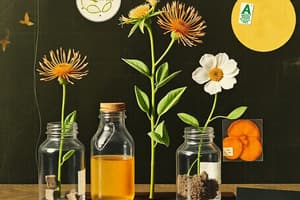Podcast
Questions and Answers
What color does the iodine solution turn when it reacts with starch?
What color does the iodine solution turn when it reacts with starch?
- Clear
- Yellow-brown
- Blue
- Dark blue or blue-black (correct)
Which solution is used to test for glucose?
Which solution is used to test for glucose?
- Iodine solution
- Potassium hydroxide solution
- Benedict's solution (correct)
- Biuret solution
Which of the following is NOT classified as a reducing sugar?
Which of the following is NOT classified as a reducing sugar?
- Glucose
- Fructose
- Sucrose (correct)
- Lactose
What indicates a positive test for protein using the biuret test?
What indicates a positive test for protein using the biuret test?
What happens to the solution when olive oil is mixed with ethanol and then added to water?
What happens to the solution when olive oil is mixed with ethanol and then added to water?
In the glucose test, what color change indicates the presence of reducing sugars after heating?
In the glucose test, what color change indicates the presence of reducing sugars after heating?
Which component is added first in the biuret test for proteins?
Which component is added first in the biuret test for proteins?
What is the purpose of heating the test tube with Benedict's solution?
What is the purpose of heating the test tube with Benedict's solution?
Flashcards
Iodine Test
Iodine Test
A test that uses iodine solution to detect the presence of starch. Starch reacts with iodine to produce a dark blue or blue-black color.
Benedict's Test
Benedict's Test
A test that uses Benedict's solution to identify reducing sugars. Reducing sugars react with the solution, forming a cloudy orange or brick-red precipitate.
What is a reducing sugar?
What is a reducing sugar?
A sugar that can donate electrons to another molecule, like Benedict's solution, causing a chemical reaction. This reaction is visible as a color change.
Biuret Test
Biuret Test
Signup and view all the flashcards
Lipid Test
Lipid Test
Signup and view all the flashcards
What is an emulsion?
What is an emulsion?
Signup and view all the flashcards
Why is iodine solution yellow-brown?
Why is iodine solution yellow-brown?
Signup and view all the flashcards
Why does the lipid form a cloudy layer?
Why does the lipid form a cloudy layer?
Signup and view all the flashcards
Study Notes
Starch Test
- A little starch is placed on a spotting tile.
- A drop of iodine solution is added to the starch.
- The starch turns a very dark blue or blue-black color.
- This test works on solid food samples or starch suspensions.
Glucose Test
- A small amount of glucose is placed in a test tube with water.
- The tube is shaken to dissolve the glucose.
- Several drops of Benedict's solution are added to the tube, enough to color the mixture blue.
- The test tube is placed in a water bath and heated.
- The solution gradually changes color to form an orange or brick red precipitate of copper(I) oxide.
- All single sugars and some double sugars are reducing sugars.
- Ordinary table sugar (sucrose) is not a reducing sugar.
Protein Test
- A little protein (like egg white) is placed in a test tube with some water
- The powder is mixed with the water by shaking.
- An equal volume of dilute (5%) potassium hydroxide solution is added.
- The tube shaken again
- Two drops of 1% copper sulfate solution are added.
- A purple color develops (or a pre-mixed "biuret solution").
Lipid Test
- A drop of olive oil is placed in a test tube.
- Ethanol (alcohol) is added to dissolve the oil.
- The solution is poured into a test tube filled with cold water.
- A white cloudy layer forms at the top of the water.
- This layer is a suspension of tiny lipid droplets called an emulsion.
Studying That Suits You
Use AI to generate personalized quizzes and flashcards to suit your learning preferences.




